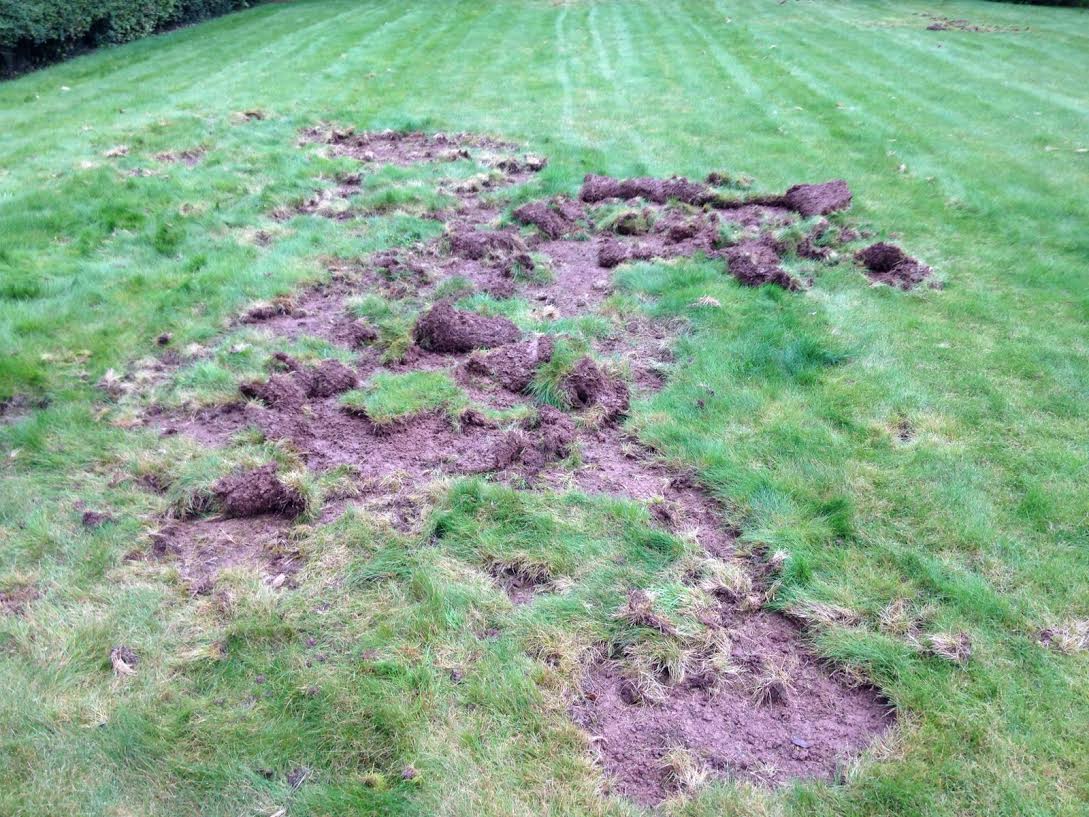A Guide to Lawn Pests
We have provided a handy guide to spotting and identifying the signs that lawn pests may have appeared in your garden.
Please use the hyperlinks below to go straight to the lawn pest you wish to read about:
What are Chafer Grubs? The larvae of the Chafer Beetle or May Grub is easily identified with its white body and orange/brown head. These grubs lay just under the soil surface in a semi-circular shape and gorge on grassroots. Telltale signs include increased bird and animal activity in affected areas as these are favoured food source. Turf can be peeled back easily due to lack of a root system and infestations can be devastating to otherwise healthy lawns and amenity areas. The most noticeable damage occurs when animals such as Badgers dig for the grubs and pull the lawn up like a rug due to the root damage caused by the Chafers.
When do Chafer Grubs appear in a lawn? Chafer grubs tend to be found in lawns that have a heavy build-up of thatch as they will feed on this organic matter. Adult chafers lay their eggs in the lawn towards the end of spring and these eggs will hatch going into the Summer months. The grubs will do the most damage to a lawn during autumn, winter and spring, when the larvae are reaching maturity.
What is the solution to Chafer Grubs? We advise first and foremost to take a preventative route by regularly having the lawn scarified and aerated (once a year) to keep the thatch layer minimal. This will reduce the likelihood of a Chafer infestation as it is removing its main food source. TopGrass can also come in after Chafer Grubs have caused damage and repair these areas with scarification and overseeding, with our Total Package.
A secondary option, once you already have Chafer Grubs in the lawn, is to try Nematodes. These are an organic solution that can be purchased online or at garden centres. Nematode treatments use millions of microorganisms which target the grubs and infect them from within and kill them off. TopGrass does not offer this service due to the nature of the Nematodes needing very specific conditions to work and the results can vary - some customers have informed us they have found success with this option.
A third option is to have our Grub Control Treatment. This is a service which was launched in 2024 and is a new product available on the professional market which we are now able to offer to our customers. For further information on this treatment, please click here to go to the Grub Control Treatment page.
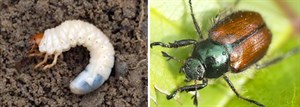
What are Leatherjackets? Leatherjackets are the larvae form of Crane Flies or Daddy Long Legs. The presence of Leatherjacket larvae in lawns will have a similar effect to Chafer Grubs and are again a favoured food supply for birds and badgers, which can devastate lawns as a result of foraging. They have short ‘worm’ like brown bodies and they will begin to gorge on grassroots as they grow. Having them in the lawn is perfectly normal however they can cause severe damage to lawns in some cases when populations reach high levels. Eggs are usually laid around the edges of the lawn and as they begin to eat the roots of the grass, patches of yellowing unhealthy looking grass will begin to appear. As they continue to feed, the grass in these areas will die off and leave areas of bare soil. These patches can spread rapidly across the lawn.
When do Leatherjackets appear in a lawn? Crane flies will lay their eggs during late July and August. The larvae will then hatch around 2 weeks after this. This is when you will see damage to your lawn occur as they start to feed on the grassroots throughout autumn, winter and spring. Damage to lawns usually is at its worst during the early spring and end of summer, however with milder winters they can come to the surface early (Jan/Feb) and start causing damage.
What is the solution to Leatherjackets: Similar to Chafer Grubs, we advise regular scarification and aeration first as a preventative method. Then there is the same Nematodes option for Leatherjackets, which you can opt to purchase and apply yourselves, and finally our Grub Control Treatment which you can find out more about by clicking here. We can also come in and repair any damage caused by Leatherjackets once they have run their course through scarification and overseeding, with our Total Package.
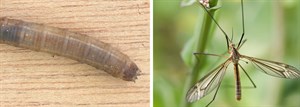
What are worms and wormcasts? Of the many species of worms found in the UK, only a few will leave unsightly casts on the surface of the lawn. Worm casts are small piles of damp soil formed from earth being ejected from the digestive system of some species of worm. Generally speaking, worms are great for a lawn as they will improve soil quality and fertility - they are actually vital for healthy soils. They are not harmful to developing plants and only consume decaying plant material. Worms are in fact a sign that you have good, healthy soil! Different worm types have different roles, but their main roles are to break down organic matter, mix the organic and mineral elements in the soil to provide nutrient mobilisation for plants, and they also create deep burrows that help water movement and root development!
When do wormcasts appear in a lawn? Wormcasts tend to show up the most during autumn and early spring, when the weather is much wetter. It is best to keep off the lawn when the worm casts are prevalent and still very wet.
what is the solution to wormcasts? When dry, wormcasts can be dispersed over the lawn with a quick sweep of a firm bristle brush. While unsightly during the autumn, winter and spring, wormcasts do not cause damage to your lawn and can be dispersed easily once dry.
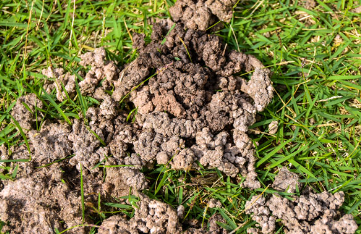
What are ants? Ants are quite a common issue in lawns and can cause health as well as visual issues with a lawn. The process of their nest-building can actually damage grassroots (causing dead patches) and pose a hazard for people walking on the lawn and mowers running over it.
When do ants appear in a lawn? Ants will tend to appear in dry soil in relatively quiet/undisturbed areas and are most active between April and October.
What is the solution to ants? Unfortunately, there is no effective treatment for ants in a lawn, mainly due to the size of the colonies. To care for your lawn during ant activity, it is advisable to keep the small mounds of finings, created through burrowing activity, dispersed around the lawn. Usually, a couple of sweeps with a firm bristle brush will keep the lawn level. If the mounds are allowed to grow in size and the nest is ever abandoned, the mounds will become hard clay lumps after time/rainfall where mowers will catch and scalp the lawn. Regular scarifying will help reduce these hard lumps.
Active nests may be reduced slightly by ensuring a supply of ant powder/liquid is introduced into the heart of the nest via a hole made by a stake or a slit made by a spade and covered after. Ant bait type products can be very effective, these should also be introduced into the nests if possible. These products are available at most garden centres.
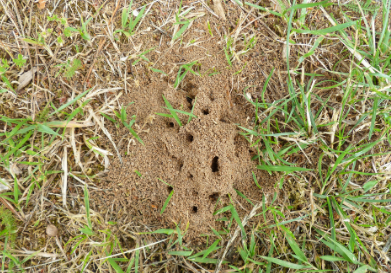
What are moles? You will most likely never see a mole, but you will certainly see the molehills they create in your garden. They essentially dig a system of tunnels underground and get rid of the soil by throwing it up to the surface. Lawns can be devastated by the molehills and shallow tunnels that can disturb the roots of seedlings and cause areas of lawns to collapse. Moles are carnivorous mammals so they are not a danger to plants or the roots of the grass.
When do moles appear in a lawn? Moles can appear in lawns all year round. However, moles tend to be most active during late winter and early spring. Molehills in a lawn will usually be caused by a single mole due to their terroritorial nature.
What is the solution to moles? A professional mole-catcher is about the only way to rid a lawn of moles and these can be found either by local recommendation or online. You can attempt to remove molehills manually to assist in levelling out the lawn and also to fill up the holes that have been left by the moles.
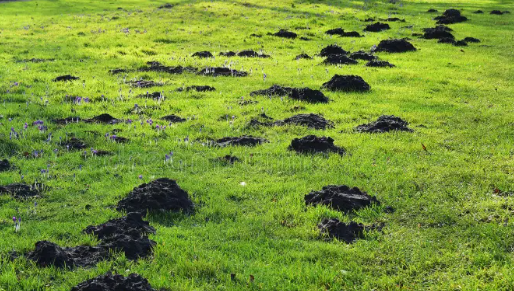
What are badgers? Badgers are constantly foraging for food with digger-like paws on the end of strong, muscular legs. Colonies of badgers searching for grubs and worms can devastate a healthy lawn which would usually need major renovation or landscaping to rectify.
When do badgers appear on a lawn? Badgers are active throughout the year, but they are most active between April to June. You will most likely realise you have a badger problem if you see sections of your lawn torn up from them looking for grubs in the soil (an example can be seen below).
What is the solution to badgers? Some households install low-level electric wire fences around the lawn perimeter but this is not always an easy option, so making perimeters secure by blocking access under gates/fences can work. Regular scarifying of lawns will help reduce pests and the level of repairs needed should damage occur. Please also see the Leatherjacket and Chafer Grub sections above to ways of reducing the likelihood of grubs appearing in your lawn which are a food source for badgers.
